Blog & Latest Updates
Fly Fishing Articles
Insects by Common Name


Caddisfly Family Hydropsychidae
Taxonomic Navigation -?-
Kingdom
Animalia (Animals)
» Phylum
Arthropoda (Arthropods)
» Class
Insecta (Insects)
» Order
Trichoptera (Caddisflies)
» Family Hydropsychidae
5 genera aren't included.
Hydropsyche is the best-known and most important genus in the family but Cheumatopsyche has some significant hatches as well.
Two species of note from the other genera are Potamyia flava, a relatively unimportant Southern species, and Macrostemum zebratum, the important species commonly known as the "Zebra Caddis."
Hatching Behavior
Before emerging, Hydropsychidae pupae drift along the bottom or just under the surface for an unusually long time, from a few minutes to a few hours. They then take an unusualy long time struggling out through the film. Both of these tendencies make them more ideal for the angler.
Egg-Laying Behavior
Gary LaFontaine writes in Caddisflies that Hydropsychidae females dive to lay their eggs on the river bottom. When they're done, instead of swimming back to the surface quickly, they dead-drift (Dead-drift: The manner in which a fly drifts on the water when not moving by itself or by the influence of a line. Trout often prefer dead-drifting prey and imitating the dead-drift in tricky currents is a major challenge of fly fishing.) and float up. This makes them exceptionally vulnerable to trout.
Swisher and Richards in Selective Trout say that some species oviposit by flying low over the surface and dipping their abdomens slightly into the water repeatedly lay eggs. I'm inclined to believe Swisher and Richards about the variation, and to assume that the behavior LaFontaine described is by far the more common of the two.
Larva & Pupa Biology
Diet: Microorganisms filtered by their nets
Current Speed: Medium to fast
Shelter Type: Nets instead of cases; may build shelters near nets
Hydropsychidae is the main family of net-spinning caddisflies. Instead of building cases to live in, they build small silk nets (usually between 0.5cm and 2cm across) over crevices in rocks and logs. The current brings their microscopic prey into these traps. One larva may build and tend to more than one net.Current Speed: Medium to fast
Shelter Type: Nets instead of cases; may build shelters near nets
Many larvae of Hydropsyche (and perhaps the others, though I have not
On page 231 of Caddisflies, Lafontaine presents a very interesting chart relating the abundance and net mesh size of each Hydropsychidae genus to different habitat factors like river size and water temperature. Rather than try to summarize it here I will recommend that you buy the book.
Hydropsychidae Fly Fishing Tips
Because they are so common, imitations of this family perform very well as searching patterns (Searching pattern: Any artificial fly pattern used when trout that aren't feeding selectively on anything in particular. A searching pattern may be an attractor or an imitation of something specific that the fish might favor even though it's not currently hatching.). Most of the fashionable "Czech Nymphs" imitate Hydropsychidae larvae, as do Cinnamon Caddis dry flies, which perform very well according to a 1998 study in the British Medical Journal, paraphrased again in that journal and quoted here:
Many doctors fish for trout, but there have been endless arguments over the best choice of fly. To extend evidence based practice from their professional into their leisure hours (where it might conceivably be more useful) Britton et al ( p 1678) carried out a randomised trial of five different dry flies (artificial floating flies) on the River Kennet in Berkshire. Before the trial the investigators had most confidence in the Grey Wulff and least in the Cinnamon Sedge. In the trial the Cinnamon Sedge caught the most trout and also seemed to be significantly favoured by brown as opposed to rainbow trout. These findings are of biological as well as practical importance, but the trial was small and the authors press the urgent need for much more research.
Clearly more research is necessary to settle the issue convincingly. As the authors of the study point out,
None of the investigators has any intention of taking the slightest notice of the results of this study.
I vow to fish as much as possible until the question of which dry fly is best has been firmly resolved to the agreement of all.
Pictures of 28 Caddisfly Specimens in the Family Hydropsychidae:
Hydropsyche aenigma (Spotted Sedge) Caddisfly Adult View 18 PicturesThese big caddisflies were tempting trout as they wriggled out of their shucks (
View 18 PicturesThese big caddisflies were tempting trout as they wriggled out of their shucks (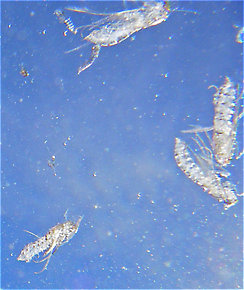 Shuck: The shed exoskeleton left over when an insect molts into its next stage or instar. Most often it describes the last nymphal or pupal skin exited during emergence into a winged adult.), while others skated across the water at a medium pace, probably egg-laying.
Shuck: The shed exoskeleton left over when an insect molts into its next stage or instar. Most often it describes the last nymphal or pupal skin exited during emergence into a winged adult.), while others skated across the water at a medium pace, probably egg-laying.
 View 18 PicturesThese big caddisflies were tempting trout as they wriggled out of their shucks (
View 18 PicturesThese big caddisflies were tempting trout as they wriggled out of their shucks (
Here's an underwater view of the pupal shucks of several already-emerged Brachycentrus numerosus caddisflies.
Collected May 15, 2007 from the West Branch of the Delaware River in New York
Added to Troutnut.com by Troutnut on May 18, 2007
Added to Troutnut.com by Troutnut on May 18, 2007
Cheumatopsyche (Little Sister Sedges) Caddisfly Adult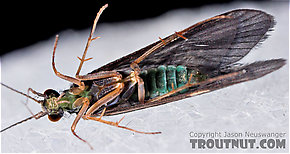 View 9 Pictures
View 9 Pictures
 View 9 Pictures
View 9 PicturesCollected September 19, 2006 from Mystery Creek #43 in New York
Added to Troutnut.com by Troutnut on October 4, 2006
Added to Troutnut.com by Troutnut on October 4, 2006
Hydropsyche (Spotted Sedges) Caddisfly Pupa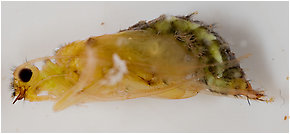 View 8 PicturesSeveral users have interesting comments in the discussion of this specimen, but this observation by Creno is especially good:
View 8 PicturesSeveral users have interesting comments in the discussion of this specimen, but this observation by Creno is especially good:
 View 8 PicturesSeveral users have interesting comments in the discussion of this specimen, but this observation by Creno is especially good:
View 8 PicturesSeveral users have interesting comments in the discussion of this specimen, but this observation by Creno is especially good:Also, this is what I would call an "immature" pupa. The wingpads of caddis pupae darken to nearly black as the enclosed adults near emerging. The darkening is the developing adult wing inside the pupal wing pad (Wing pad: A protrusion from the thorax of an insect nymph which holds the developing wings. Black wing pads usually indicate that the nymph is nearly ready to emerge into an adult.). The ultimate coloration of the adult wing is not very apparent in most pupal wing pads (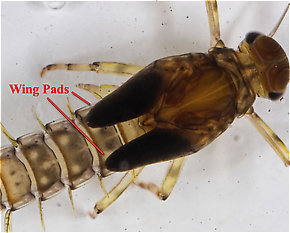 The wing pads on this final instar Baetidae mayfly nymph are extremely dark.Wing pad: A protrusion from the thorax of an insect nymph which holds the developing wings. Black wing pads usually indicate that the nymph is nearly ready to emerge into an adult.) as the majority of the adult wing coloration comes from the color/position of the adult wing hairs and setae (Seta: Little hairs on insects.). But dark pupal wingpads are a good indication that the emergence will occur very soon, likely that day or so, and that the adult parts are sufficiently developed within the pupae to make a species determination from the specimen, particularly if it is a male.
The wing pads on this final instar Baetidae mayfly nymph are extremely dark.Wing pad: A protrusion from the thorax of an insect nymph which holds the developing wings. Black wing pads usually indicate that the nymph is nearly ready to emerge into an adult.) as the majority of the adult wing coloration comes from the color/position of the adult wing hairs and setae (Seta: Little hairs on insects.). But dark pupal wingpads are a good indication that the emergence will occur very soon, likely that day or so, and that the adult parts are sufficiently developed within the pupae to make a species determination from the specimen, particularly if it is a male. The wing pads on this final instar Baetidae mayfly nymph are extremely dark.
The wing pads on this final instar Baetidae mayfly nymph are extremely dark.
Collected May 13, 2007 from the Delaware River in New York
Added to Troutnut.com by Troutnut on May 18, 2007
Added to Troutnut.com by Troutnut on May 18, 2007
1 Underwater Picture of Hydropsychidae Caddisflies:
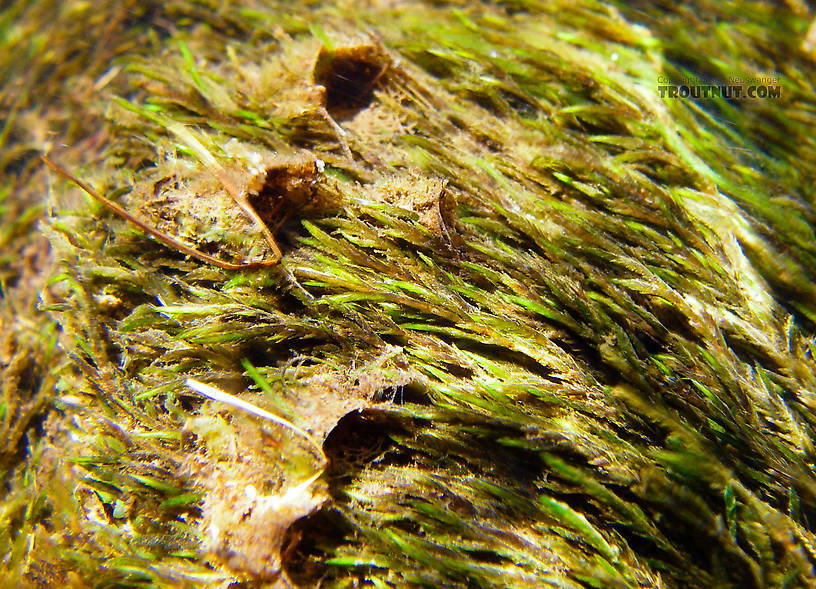
These big bucket-like nets on the weeds are home to Hydropsychid caddisflies, as I verified by actually taking one apart to look at its inhabitant.
In this picture: Caddisfly Family Hydropsychidae.
In this picture: Caddisfly Family Hydropsychidae.
Recent Discussions of Hydropsychidae
Correct hatch time of year Hydropsyche slossonae? 10 Replies »
Posted by AndyV on Aug 26, 2022 in the species Hydropsyche slossonae
Last reply on Oct 11, 2022 by AndyV
I've seen hatch charts (e.g. DNR hatch chart for SE MN) stating mid-May til the end of July vs June (from this site). Can anyone confirm?
ReplyArctopsyche grandis in waterton canyon 1 Reply »Posted by Krikut on May 16, 2016 in the species Arctopsyche grandis
Last reply on May 17, 2016 by Bnorikane
Discovered one of these guys or (gals?) back on March 20 of this year up in Waterton Canyon. He was so chunky I first thought it was a small hellgrammite (I grew up in Virginia, where the hellgrammite was the bug of choice in most smallmouth rivers). This particular one measured about half an inch and had a bright green tail/foot segment. I'm curious if you guys have a favorite immitation? Thanks!
ReplyArctopsyche Grandis 6 Replies »Posted by Epeorus on Jul 2, 2014 in the genus Arctopsyche
Last reply on Jul 6, 2014 by Entoman
A while ago there was some discussion of this bug in Colorado. I first came across this beast in early July 2011 on the Eagle River, just downstream of Edwards, Co. Met him again this week on the Eagle. It's quite the blast - big bugs and big trout. Especially the ones rising with abandon in the fast water in the middle of the day.
Funny thing is we don't seem to see these guys most years. The commonality between 2011 and this year is an extended runoff leading to cold and high - though clear water in early July. I wonder if they normally hatch during the peak of the runoff when no one is on the water.
I remember people commenting about these caddis allegedly being in parts of Colorado. The hatches the last two days on the Eagle and what I saw in 2011 would add some level of credence to that belief.
A size 10 (on a Partridge L3A) sponge body caddis with a dark gray body, and a size 10 Lafontaine sparkle emerger with a gray body and a clear shroud were the ticket.
ReplyArctopsyche grandis 6 Replies »Funny thing is we don't seem to see these guys most years. The commonality between 2011 and this year is an extended runoff leading to cold and high - though clear water in early July. I wonder if they normally hatch during the peak of the runoff when no one is on the water.
I remember people commenting about these caddis allegedly being in parts of Colorado. The hatches the last two days on the Eagle and what I saw in 2011 would add some level of credence to that belief.
A size 10 (on a Partridge L3A) sponge body caddis with a dark gray body, and a size 10 Lafontaine sparkle emerger with a gray body and a clear shroud were the ticket.
Posted by Flymonster on Sep 8, 2011 in the species Arctopsyche grandis
Last reply on May 20, 2013 by Flymonster
Here in the Willamette Valley the McKenzie Caddis (as Arctopsyche grandis is known locally) usually begins its emergence sometime around mid-May and can continue into mid-June. The most emergence activity will be noted on warm days once the water temperature reaches @ 52f. Most hatches occur on warm sunny days from 4pm-7pm. Arlen Thomason goes into great detail about the life-cycle and behaviors of a. grandis in his book "Bug Water".
At least for me, the McKenzie Caddis, marks the beginning of summer and excellent fly fishing for trout on the McKenzie, Middle Fork Willamette, North Fork of the Middle Fork Willamette, and our other local rivers and streams.
ReplyWhat flies to imitate 12 Replies »At least for me, the McKenzie Caddis, marks the beginning of summer and excellent fly fishing for trout on the McKenzie, Middle Fork Willamette, North Fork of the Middle Fork Willamette, and our other local rivers and streams.
Posted by Goose on Sep 19, 2006 in the genus Ceratopsyche
Last reply on Mar 21, 2010 by Martinlf
Jason: What species', in common angler language, are represented in this genus? I'm trying to determine which ones I should spend my time on imitating them. Are they October Caddis, Grannom Caddis, etc. Are those afore mentioned sedges? I would like to know the names so I can tie them the correct size and colors. Just trying to learn. Thanks
ReplyThere is 1 more topic.
Your Thoughts On Hydropsychidae:
Top 10 Fly Hatches
Top Gift Shop Designs
Eat mayflies.
Top Insect Specimens
Miscellaneous Sites
Troutnut.com is copyright © 2004-2024 Jason
Neuswanger (email Jason). See my FAQ for information about use of my images.
 privacy policy
privacy policy
